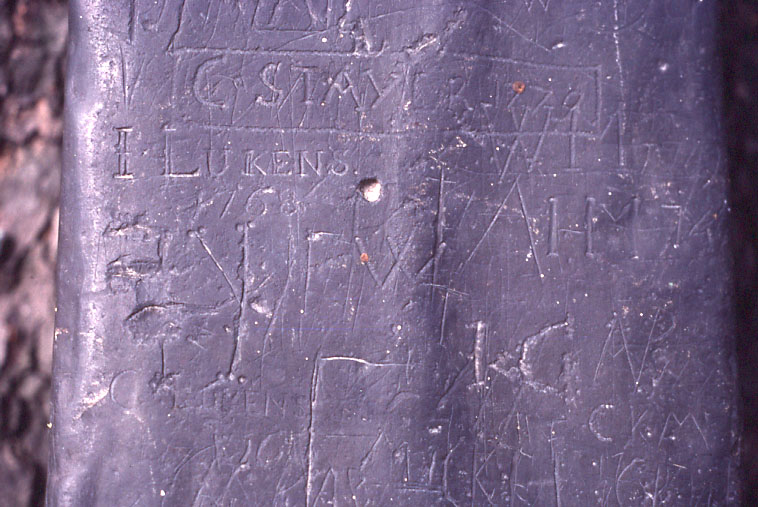FROM AN ACCOUNT WRITTEN BY WILLIAM RUDOLPH SMITH, GRANDSON OF REV. WILLIAM SMITH, FOUNDER OF THE TOWN OF HUNTINGDON
Huntingdon, the village, was laid out into lots on land belonging to the Rev. Dr. William Smith, and was called by him “Huntingdon” in honor of Selina, Countess of Huntingdon, a lady distinguished in the religious history of the eighteenth century. The village is located on the northern bank of the Juniata River, at the point where Stone Creek empties into it. When a new county was laid off from Bedford County in 1787, it was called “Huntingdon” after its principal village.
It has always been well understood, and within my recollection was well known by some of the old inhabitants of this section of country, that the site of the village of Huntingdon was once occupied by a band of Indians (supposed to be Oneidas), and their Indian camp or village was known over all this part of Western Pennsylvania as “Stone Town” or rather “Standing Stone Town.” The name is still preserved in “Stone Creek,” which here empties into the Juniata, and in “Stone Valley,” an important agricultural section extending from Huntingdon northwardly to the line of Centre County.
The name of “Standing Stone” was given to this place from the fact that the band of Indians alluded to had erected a stone pillar (a monolith) in their village, and tradition says that this band always carried the stone with them in their migrations, or erected a similar one wherever they selected an abiding place.
Whether the stone, of which I shall now speak, was the original stone of the Indians, or one which the white inhabitants erected after the Indians had removed and had taken the original with them, I cannot say with certainty, as in my time, there were contradictory accounts and assertions on this subject. I am inclined to the opinion that the Indians, on their removal, took their monument with them, and that another stone had been erected, at a very early day, by the whites in commemoration of the name of this locality.
Dr. William Smith had built a dwelling house in the village and had caused this stone to be removed to the yard, in the rear of this house, and here, lying on the ground, I first saw the “Standing Stone,” — the modern one. This was in 1805. In 1809 I removed to Huntingdon and resided in this house. The stone still remained where it had laid for many years, and as long as I lived on the premises, it was well taken care of, but when I removed to a residence which I had built on the opposite side of the street (about 1815), some mischievous or malicious persons broke the stone into fragments.

This fragment of the second Standing Stone, which Smith and Africa describe, is displayed in the lobby of the present Huntingdon County courthouse. The inscriptions “I. Lukens” and “1768” are clearly visible in the photograph. John Lukens (1720-1789) was Pennsylvania’s first Surveyor General. He inscribed the initial “I,” rather than “J,” for his first name, as was sometimes the practice followed from earlier times when they were the same letter.
This stone was about nine feet in length, and at its base was about sixteen inches wide, tapering on both sides to the top, which was about eight inches wide. Throughout, the stone was about five inches thick. It had an uneven surface, but on its smooth parts several names were cut or scratched, apparently with a knife or nail.*
The “Standing Stone” was a landmark in early days for surveyors and travellers, and evidence of this appears in the names cut upon it in the year 1768. John Lukens was Surveyor General of Pennsylvania. Charles Lukens also was a surveyor, and Thomas Smith, the brother of Dr. William Smith, was a large land owner in this part of the State.
I always believed that this stone had been taken from the bed of the Juniata River. A great portion of the stone with which I built my house at Huntingdon had been procured out of the river, where much of the rock was lamellated and easily detached. The color of the stone was a very dark blue, and I think the quality was a hard limestone, but of this I am not certain.
Source: William Rudolph Smith Papers, Wis Mss CV, Wisconsin Historical Society, Madison, Wisconsin. Used with permission.
* J. Simpson Africa’s History of Huntingdon and Blair Counties (1883) adds this information about the stone: “The early history of [Huntingdon] borough carries us back to the traditions of the Indian occupation and the reminiscences of the early Indian traders…. They erected near the river,… a tall, slim pillar of stone, covered with hieroglyphics, presumed to embody the history as well as a record of the achievements of the tribe.… It is supposed that this stone was carried off by the Indians when they emigrated elsewhere, as they regarded it with great veneration. Subsequently another stone was erected by the whites on the site of the original one, and was accidentally broken by a misthrow in the play of ‘long-bullets.’ Upon it, beside many cabalistic characters, were cut the names of John Lukens (with the date 1768), Charles Lukens, Thomas Smith, and others.”
